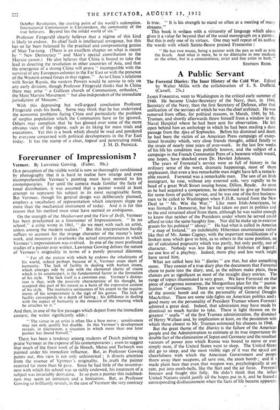Forerunner of Impressionism ?
Vermeer. By Lawrence Gowing. (Faber. 50s.) OUR perception of the visible world is now so thoroughly conditioned by photography that it is hard to realise how strange and even incomprehensible Vermeer's painting must have seemed to his contemporaries. For until the camera made familiar the facts of tonal distribution, it was assumed that a painter would at least attempt to represent his subject in its most recognisable form. But Vermeer, though his general design was deliberately planned, employs a vocabulary of representation which interprets shape no more than the mechanical instrument of today. And it is for this reason that his method must once have seemed ,so ambiguous.
On the strength of the Maidservant and the View of Delft, Vermeer has been proclaimed as a forerunner of Impressionism. "In no school," a critic wrote in 1861, " do we meet with such an artist, unless among the modern realists." But this interpretation hardly suffices to account for the strange character of the master's later work, and moreover it overlooks the actual circumstances in which Vermeer's impressionism was evolved. In one of the most profound studies of a painter ever written, Lawrence Gowing defines the nature of Vermeer's originality in terms of a purely personal dilemma.
"For all the stature with which he endows the inhabitants of his world, indeed perhaps because of it, Vermeer stops short of humanity. The lack of facility in dealing with human issues, which emerges side by side with the elemental clarity of vision which is its counterpart, is the fundamental factor in the formation of his style. The lack itself is a common one. Vermeer's distinc- tion is that, with the passivity characteristic of his thought, he accepted this part of his nature as a basis of the expressive content of his style. The instinctive seriousness of his assent to the require- ments of his temperament is the sign of his genius. The lack of facility corresponds to a depth of feeling ; his diffidence in dealing with the aspect of humanity is the measure of the meaning which he attaches to it."
And then, in one of the few passages which depart from the immediate context, the writer significantly adds :
" The virtue in an artist is often like a bare nerve ; sensitiveness may not only qualify but disable. In this Vermeer's development reveals, in microcosm, a situation in Which more than one later painter has found himself."
There has been a tendency among students of Dutch painting to praise Vermeer at the expense of his contemporaries ; even to suggest that much of the finest work of de Hooch, Metsu and Terborch was painted under his immediate influence. But, as Professor Gowing points out, this view is not only unhistorical 2 • it diverts attention from the' essence of Vermeer's originality. In_truth the painter received far more than he gave. Since he had little of the inventive- ness with which his school was so richly endowed, his treatment of a subject was invariably derivative. In so pure a painter this indebted- ness may seem an intrusion and a limitation. But, as .Professor Gowing so brilliantly reveals, in the case of Vermeer the very contrary is true. "It is his strength to stand so often at a meeting of many streams."
This book is written with a virtuosity, of language which alone gives it a value far beyond that of the usual monograph on a painter. But this is only one of its virtues. One may well repeat of its author the words with which Sainte-Beuye praised Fromentin : "He has two muses, being a painter with the pen as well as with the brush. And what is more, he is no dilettante in one medium or the other, but is a conscientious, strict and fine artist in both."
STEPHEN REISS.


























 Previous page
Previous page